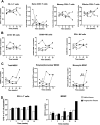An Open-Label Study of Subcutaneous CpG Oligodeoxynucleotide (PF03512676) in Combination with Trastuzumab in Patients with Metastatic HER2+ Breast Cancer
- PMID: 38797949
- PMCID: PMC11129578
- DOI: 10.1177/10732748241250189
An Open-Label Study of Subcutaneous CpG Oligodeoxynucleotide (PF03512676) in Combination with Trastuzumab in Patients with Metastatic HER2+ Breast Cancer
Abstract
Objectives: CpG ODN is a Toll-like receptor 9 agonist with immunotherapeutic potential for many cancer types, including aggressive breast cancers. There is strong interest in utilizing CpG ODN as an adjuvant to improve clinical efficacy of current treatments and immunogenicity of breast cancers not traditionally responsive to active immunotherapy, such as those that are human epidermal growth factor receptor 2 (HER2)-positive. This study aimed to study the efficacy and safety of combination CpG ODN plus anti-HER2 antibody trastuzumab treatment in patients with advanced/metastatic breast cancer.
Methods: This single-arm, open-label phase II clinical trial treated patients (n = 6) with advanced/metastatic HER2-positive breast cancer with weekly subcutaneous CpG ODN and trastuzumab. Patients may have received any number of prior therapies to be enrolled (most enrolled at median 1 prior line of chemotherapy). Peripheral blood was collected at baseline and weeks 2, 6, 12, and 18 for immune analyses. Six patients were enrolled and 50% achieved stable disease (SD) response.
Results: Median PFS was 8.3 months. Three of the six patients enrolled opted to stop treatment due to tolerability issues. Multiplex assay for cytokine measurements revealed significantly higher VEGF-D levels at week 2 compared to baseline. Peripheral blood mononuclear cells analyzed by flow cytometry showed a significant increase in monocytic MDSC between weeks 6 and 12. Patients with progressive disease tended to have higher levels of week 6 monocytic MDSC and PD-1+ T cells than patients with SD. NK cell populations did not significantly change throughout treatment.
Conclusions: CpG ODN and trastuzumab treatment of metastatic HER2 + breast cancer was safe but was not tolerable for all patients. This combination did induce potentially predictive immune profile changes in treated patients with metastatic HER2 + breast cancer, the significance of which needs to be further explored.
Keywords: CpG ODN; TLR9; breast cancer; clinical trials; human epidermal growth factor receptor 2; immunotherapy; toll-like receptor 9; trastuzumab.
Plain language summary
Why was the study done? Breast cancer that has metastasized (moved outside of the breast and local lymph nodes) is currently considered incurable and can be difficult to treat. Treatments that can stimulate the immune system to recognize cancer cells have been found to be useful for many types of cancers, including some types of breast cancers. This study tested a new immune stimulator (CpG ODN) in combination with a currently on-the-market antibody treatment for breast cancer (trastuzumab). What did the researchers do? The research team enrolled patients who had metastatic breast cancer and treated them all with a combination of trastuzumab and CpG ODN for 12 weeks. These patients were monitored for any side effects/toxicity, monitored for how long their breast cancer responded to this treatment, and monitored for how long they lived after beginning this treatment. Patients also had their blood drawn at different time points to observe how their immune cells and immune proteins (e.g. cytokines) changed on treatment. What did the researchers find? The research team enrolled six patients and found that the treatment was safe and that 50% of the patients treated did not have any breast cancer growth when given CpG ODN plus trastuzumab. Looking at the immune cells in the patient blood samples, some cells that are known to decrease the immune response to cancers (myeloid-derived suppressor cells) did increase towards the end of treatment. What do the findings mean? Overall, CpG ODN and trastuzumab treatment was found to be safe and potentially effective in preventing breast cancer growth.
Conflict of interest statement
Declaration of Conflicting InterestsThe author(s) declared no potential conflicts of interest with respect to the research, authorship, and/or publication of this article.
Figures



References
Publication types
MeSH terms
Substances
Grants and funding
LinkOut - more resources
Full Text Sources
Medical
Research Materials
Miscellaneous

